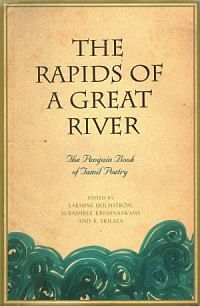Tamil Poetry: <i>akam</i> and <i>puram</i>

There is a central division in the ancient and classical literature of India. One is the Sanskritic, Indo-Aryan stream, with its roots in the Rig Veda, thought by scholars to date from about 14th century B.C. The other great parallel flow is in what is classified as the 'Dravidian' languages, almost wholly based in south India, and of an entirely different language family than Sanskrit and its derivatives.
The four principal literary Dravidian languages are Tamil, Telegu, Kannada and Malayalam, of which Tamil is the oldest. Its recorded literary tradition dates back to more than a thousand years, with the earliest being what the three translators in their introduction to this book of translations of Tamil poetry tell us is known as 'Sangam' poetry, "named after the assembly or sangam of poets based in the Pandyan capital, Madurai." It is impossible to date such beginnings with any degree of accuracy, but most scholars seem to agree that this poetry, collected in eight anthologies of lyrics, ten long poems, and a grammar treatise titled Tolkappiyam, are probably from first century to fourth century B.C.
Though the two great ancient Indian literary traditions differ vastly in almost all aspects, there seems to be a unity in terms of a tendency to write according to classificatory schemes. Just as Panini (400 B.C.) froze Sanskrit for all times with his treatise on its grammar - in order that refined speech should eternally be the hallmark of Sanskrit - so too there were rules laid down ('codified' is the proper term here) for ancient Tamil poetry in the Tolkappiyam. Simply put, it divided all Tamil poetry into akam and puram. Akam dealt with 'that which is inside' or 'the inner world' - in other words, love poems, written in highly structured forms. Puram's themes were on 'the outer world', and dealt with public life, with war, death, and the glory of kings. These poems laid the foundation for Tamil poetry, a tradition so strong that it was only from the nineteenth century onward that poets began to struggle to break, as the translators say, "free (from) traditional and prescribed forms of prosody… (and) speak with new voices and address a wide audience in the modern political and social world."
From the above it can be seen that no anthology attempting to cover Tamil poems from ancient to modern times can provide more than a glimpse of this illustrious and complex literary tradition. The Rapids of a Great River: The Penguin Book of Tamil Poetry (edited by Lakshmi Holmstrom, Subashree Krishnaswamy and K. Srilata; New Delhi; 2009) represents a laudable effort in this direction. Its first part consists of the Sangam and bhakti periods till the pre-modern age of the nineteenth century. The second part is a collection of contemporary poems and poets, including Sri Lankan Tamils, women and dalits, whose voices differ sharply from what went on for a thousand years before them. Though it is difficult to judge, without knowing the language, how well the translators have done their job, and that a careful reading and absorption of the classificatory scheme of Tamil poetry is needed to understand how the ancient Tamil poems work, the book more than serves its purpose of introducing to its readers a record of a rich literary tradition and its latter-day practitioners.
Farhad Ahmed is an occasional contributor to The Daily Star literature page.
Tiruvalluvar
(translated by P S Sundaram)
Book II: Wealth
Learning
Learn well what should be learnt, and then
Live your learning.
Those called figures and letters, the wise declare,
Are eyes to live with.
Only the learned have eyes--others
Two sores on their face!
It is a pleasure to meet a scholar,
A pain to part with him.
A scholar seeking knowledge stoops and is lofty;
The ignorant never stoop and are low.
A well dug in the sand yields water as dug--
So learning, wisdom.
Why does one stop learning till he dies
When it makes all lands and places his?
The learning acquired in one birth
Helps a man in seven.
That what delights him delights others
Delights a scholar.
The wealth which never declines
Is not riches but learning.
(verses 391-400)
Buddha murdered
M A Nuhman (1944- )
(translated by Lakshmi Holmstrom)
In my dream, last night
Lord Buddha lay, shot dead.
Government police in civilian clothes
Shot and killed him
He lay upon the steps
Of the Jaffna Library,
Drenched in his own blood.
In the darkness of the night
The ministers arrived, raging:
'His name wasn't on our list,
So why did you kill him?'
'No, sirs,' they said,
'No mistake was made. Only,
Without killing him, it wasn't possible
To shoot even a fly.
So…'
'Ok. OK. But
Get rid of the corpse at once,'
The ministers said, and vanished.
The plainclothes men
Dragged the corpse inside
And heaped upon it
Ninety thousand rare books
And lit the pyre with the Sikalokavada Sutta.
So the Lord Buddha's body turned to ashes
And so did the Dhammapada.

 For all latest news, follow The Daily Star's Google News channel.
For all latest news, follow The Daily Star's Google News channel. 



Comments